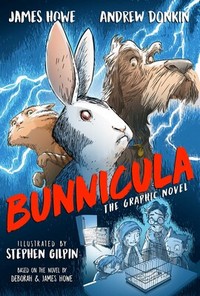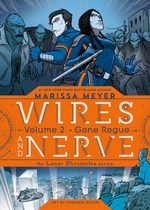 Bunnicula: The Graphic Novel
Bunnicula: The Graphic Novel
by James Howe, Andrew Donkin, Stephen Gilpin (Illustrator)
DETAILS: Publisher: Atheneum Books for Young Readers Publication Date: August 29, 2022 Format: Paperback Length: 128 pg. Read Date: October 22, 2022

What’s Bunnicula: The Graphic Novel About?
This is easy—it’s a graphic novel adaptation of the modern classic, Bunnicula: A Rabbit-Tale of Mystery by James and Deborah Howe.
For those who missed this when they were kids, briefly, it’s the story about a dog (Harold) and a cat (Chester) reacting to a rabbit that their family brings home after finding him in a movie theater. The rabbit has some distinctive patterns on his fur that remind the kids (and Chester) of a classic Dracula-type vampire, so they name him Bunnicula.
Chester’s a literary type, with a taste for classic horror. Between his look, Bunnicula’s nocturnal habits, and the fact that every vegetable in the house starts being drained of its juices, Chester becomes convinced that the new pet is a vampire and tries his best to warn the family and destroy the intruder before he harms the family. Harold’s around as the voice of reason and tries to mitigate Chester’s shenanigans before his new little buddy gets hurt. Hilarity and shenanigans ensue.
Stephen Gilpin’s Work and the Look of the Book Overall
When I saw this on the bookstore shelf, I was intrigued because the original novel was such a favorite of mine—and then my kids, too. I had no real intentions of buying it because I could always just grab the novel again to revisit, but I picked it up to give it a quick glance and the art blew me away, and I had to buy it. Chester looked good, I clicked immediately with the character design for the Monroes (particularly the boys), Bunnicula was spot-on…
But the clincher for me was Harold. He might as well have been a werewolf drinking a piña colada at Trader Vic’s, because his hair (and everything else) was perfect. Sure, now it’s expected that the dog will be my favorite character in a book—but that wasn’t my default when I first encountered the book. But it took little time for him to be my favorite character in the series*. So when Gilpin knocked that character out of the park, he won my affection. Sure, it’s based on the illustrations from the original book, but he owned it and brought the look to life.
* It’s very likely that Harold laid the groundwork for my appreciation of canine protagonists, like Chet and Oberon.
Sometimes, I wonder what the point is behind doing a graphic novel adaptation of a written work—does it really add anything? This one did—there are some nice updates (Harold uses a computer, etc.) and some visual jokes and flourishes that could only be made in this format. Gilpin clearly made the most out of what Howe and Donkin gave him.
So, what did I think about Bunnicula: The Graphic Novel?
It’d be hard (but not impossible) to make something faithful to the letter (as much as space allows) and the spirit of the novel that didn’t make me happy. But this one wowed me—it brought me back to the day I first discovered this great band of people and critters decades ago, recapturing and repackaging the magic.
I’m not sure that it’ll have that impact on everyone—I don’t know if an 8-10 year-old picking it up in 2022 is going to get hooked on the series, for example. I can’t imagine how one doesn’t, but I don’t know if they will.
I wasn’t sure how to rate this, how much of my reaction to it was based on memory and nostalgia and how much was this new work. But I know how I felt while reading it and I saw how my (now adult) children’s eyes lit up when I showed them this version of the book, and I had to go with the full five stars.
Adult fans who remember the book—grab this, you’ll have a blast. It’ll probably work its charms on younger readers, too—and hopefully will work to bring them to the original series.

This post contains an affiliate link. If you purchase from it, I will get a small commission at no additional cost to you. As always, the opinions expressed are my own.
![]()






